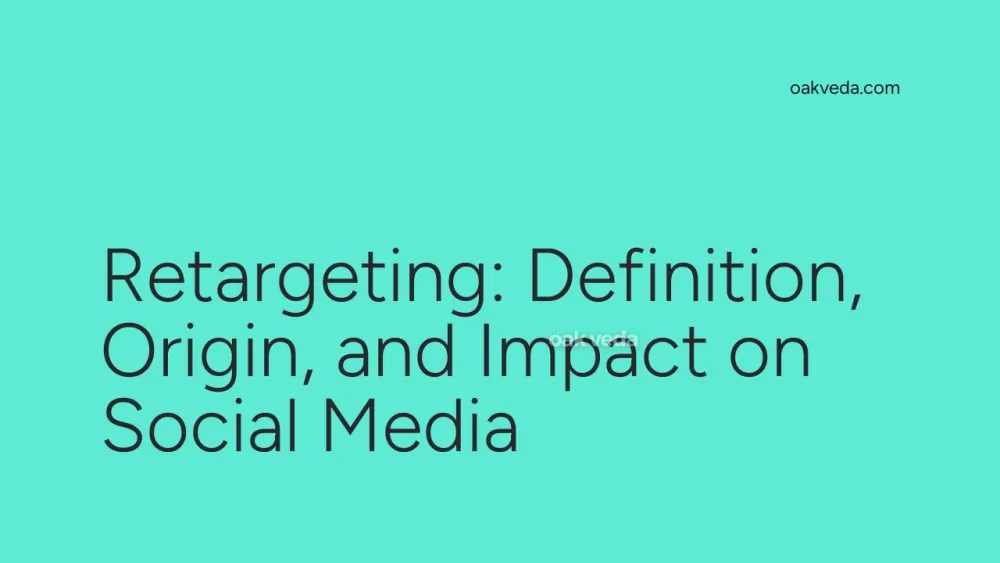
What is Retargeting?
Retargeting, also known as remarketing, is a powerful digital marketing strategy that focuses on re-engaging users who have previously interacted with a brand's website or content. This technique allows advertisers to serve targeted ads to potential customers who have shown interest in their products or services, increasing the likelihood of conversions and sales.
Origin and Development of Retargeting
The concept of retargeting emerged in the early 2000s as online advertising began to evolve. However, it gained significant traction with the rise of social media platforms and advanced tracking technologies. The ability to collect and analyze user data on a large scale made retargeting an increasingly effective and popular marketing tool.
How Retargeting Works
Retargeting relies on cookies, small pieces of data stored in a user's browser when they visit a website. These cookies allow marketers to track user behavior and serve personalized ads across various platforms. The process typically involves:
- A user visits a website or interacts with a brand's content
- A cookie is placed in the user's browser
- The user leaves the site without converting
- The brand's ads are displayed to the user on other websites or social media platforms
This continuous exposure to relevant ads increases the chances of the user returning to complete a desired action, such as making a purchase or signing up for a newsletter.
Types of Retargeting
There are several types of retargeting strategies used in social media marketing:
- Pixel-based retargeting: Uses a JavaScript code (pixel) to track website visitors and serve ads based on specific pages they've viewed.
- List-based retargeting: Targets users based on existing customer data, such as email lists or phone numbers.
- Search retargeting: Displays ads to users who have searched for specific keywords related to a brand's products or services.
- Video retargeting: Targets users who have watched a brand's video content on platforms like YouTube or Facebook.
Popular Examples of Retargeting
Many successful brands utilize retargeting in their social media marketing strategies:
- Amazon: Shows ads for products users have viewed but not purchased.
- Airbnb: Retargets users who have searched for accommodations but haven't booked.
- Spotify: Promotes premium subscriptions to free users based on their listening habits.
Impact of Retargeting on Social Media Culture
Retargeting has significantly influenced social media culture and user behavior:
- Personalized experiences: Users now expect more relevant and tailored content in their social media feeds.
- Ad fatigue: The prevalence of retargeting has led to increased ad awareness and potential ad fatigue among users.
- Privacy concerns: The use of personal data for retargeting has sparked debates about online privacy and data protection.
Controversies Surrounding Retargeting
While retargeting is an effective marketing tool, it has faced some controversies:
- Privacy issues: Some users feel uncomfortable with the level of tracking involved in retargeting.
- Ad overexposure: Poorly managed campaigns can lead to users seeing the same ads too frequently, causing frustration.
- Cross-device tracking: The practice of tracking users across multiple devices raises ethical concerns.
How Brands and Influencers Use Retargeting
Brands and influencers leverage retargeting to:
- Increase brand awareness: By repeatedly exposing users to their content and products.
- Drive conversions: Encouraging users to complete abandoned purchases or sign up for services.
- Promote new content: Targeting existing followers with ads for new blog posts, videos, or products.
- Upsell and cross-sell: Recommending related products to users who have made previous purchases.
Future Trends Related to Retargeting
The future of retargeting in social media marketing looks promising, with several emerging trends:
- AI-powered personalization: Advanced algorithms will create even more tailored ad experiences.
- Cross-platform retargeting: Seamless targeting across multiple social media platforms and devices.
- Voice-activated retargeting: As voice search grows, retargeting strategies will adapt to this new medium.
- Augmented reality integration: AR experiences may be incorporated into retargeting campaigns for more immersive ads.
FAQs about Retargeting
-
Is retargeting effective? Yes, retargeting can be highly effective, with some studies showing up to 10 times higher click-through rates compared to regular display ads.
-
How long should retargeting campaigns run? The duration varies, but most experts recommend 30-60 days for optimal results without causing ad fatigue.
-
Can users opt-out of retargeting? Yes, most platforms offer options for users to opt-out of personalized ads or clear their cookies.
-
What's the difference between retargeting and remarketing? While often used interchangeably, remarketing typically refers to email campaigns, while retargeting focuses on display ads.
-
How does GDPR affect retargeting? GDPR requires explicit consent for data collection and use, impacting how retargeting campaigns are implemented in the EU.
In conclusion, retargeting has become an integral part of social media marketing, offering brands and influencers a powerful tool to re-engage potential customers. As technology advances and privacy concerns evolve, retargeting strategies will continue to adapt, shaping the future of digital advertising in the social media landscape.
You may be interested in:
- Social Media Analytics: Definition, Origin, and Impact
- CapCut: Definition, Origin, and Impact on Social Media
- Viral: Definition, Origin, and Impact on Social Media
- Linktree: Definition, Origin, and Impact on Social Media
- Retweet: Definition, Origin, and Impact on Social Media
- Ick: Definition, Origin, and Impact on Social Media Culture

